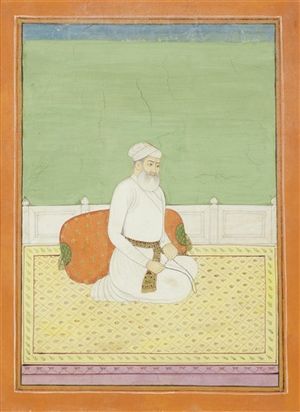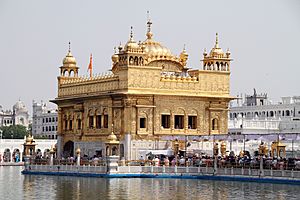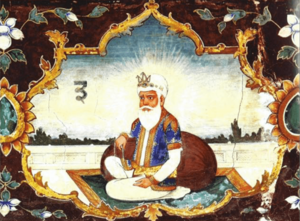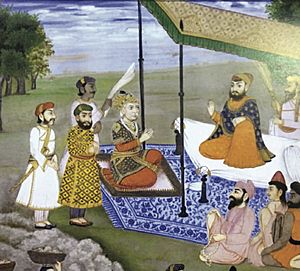Guru Amar Das facts for kids
Quick facts for kids Guru Amar Das |
|
|---|---|
| ਗੁਰੂ ਅਮਰ ਦਾਸ | |

Late 18th century painting of Guru Amar Das
|
|
| Religion | Sikhism |
| Known for | |
| Other names | Third Master Third Nanak |
| Personal | |
| Born | Amar Das 5 May 1479 Basarke, Delhi Sultanate (present-day Amritsar district, Punjab, India) |
| Died | 1 September 1574 (aged 95) Goindwal Sahib, Mughal Empire (present-day Punjab, India) |
| Spouse | Mansa Devi |
| Children | Bhai Mohan (1507 - 1567) Bhai Mohri (1514 - 1569) Bibi Dani (1526 - 1569) Bibi Bhani (1532 - 1598) |
| Parents | Tej Bhan & Mata Lachmi |
| Religious career | |
| Based in | Goindval |
| Period in office | 1552–1574 |
| Predecessor | Guru Angad |
| Successor | Guru Ramdas |
Guru Amar Das (Gurmukhi: ਗੁਰੂ ਅਮਰ ਦਾਸ, pronunciation: [gʊɾuː əməɾᵊ d̯aːsᵊ]) was the third of the Ten Gurus of Sikhism. He was born on May 5, 1479, and became the Sikh Guru on March 26, 1552, when he was 73 years old. He is sometimes called Guru Amardas.
Before he became a Sikh, Amar Das was looking for a spiritual teacher, known as a guru. One day, he heard his nephew's wife, Bibi Amro, singing a hymn by Guru Nanak. This song deeply touched him. Bibi Amro was the daughter of Guru Angad, who was the second Guru of the Sikhs at that time. Amar Das asked Bibi Amro to introduce him to her father. In 1539, at the age of sixty, Amar Das met Guru Angad and became a Sikh. He dedicated himself to serving the Guru. In 1552, before he passed away, Guru Angad chose Amar Das to be the third Guru of Sikhism.
Guru Amar Das made important changes to the Sikh faith. He created a religious system called the Manji system. This system involved appointing trained leaders to spread the Sikh teachings. This system grew and is still used today. He also wrote and collected many hymns into a book called a Pothi. These hymns later became part of the Adi Granth, the holy scripture of Sikhism.
Guru Amar Das led the Sikhs until he was 95 years old. He chose his son-in-law, Bhai Jetha, to be his successor. Bhai Jetha later became known as Guru Ram Das.
Contents
Early Life and Spiritual Journey
Amar Das was born on May 5, 1479, in Basarke village, in what is now the Amritsar district of Punjab, India. His parents were Bakht Kaur (also known as Lakshmi or Rup Kaur) and Tej Bhan Bhalla. His family belonged to the Bhalla clan of the Khatri caste. He married Mansa Devi, and they had four children: Mohri, Mohan, Dani, and Bhani.
For most of his life, Amar Das followed the Vaishnavism tradition of Hinduism. He was known for going on many pilgrimages, about twenty times, to holy places in the Himalayas and to Haridwar on the Ganges river. Around 1539, during one of these Hindu pilgrimages, he met a Hindu monk. The monk asked him why he did not have a guru (a spiritual teacher or guide). Amar Das then decided he needed to find one. When he returned home, he heard Bibi Amro, the daughter of Guru Angad, singing a hymn by Guru Nanak. From her, he learned about Guru Angad. With Bibi Amro's help, he met the second Guru of Sikhism and accepted him as his spiritual teacher. Guru Angad was much younger than Amar Das.
In the Sikh tradition, Guru Amar Das is famous for his deep dedication to Guru Angad. Stories say he would wake up very early to fetch water for Guru Angad's bath. He also helped clean and cook for the volunteers who gathered with the Guru. He spent a lot of time meditating and praying in the mornings and evenings.
Becoming a Guru
After serving Guru Angad and the Sikh community for eleven years with great devotion, Amar Das was chosen as the third Guru. Guru Amar Das moved to Goindwal, a town not far from Khadur, on the bank of the Beas river. He moved there to avoid problems with Guru Angad's sons, who were unhappy that he was chosen over them.
Even in Goindwal, one of Guru Angad's sons, named Datu, bothered him. Datu came to Goindwal and said, "Only yesterday you were a water-carrier in our house, and today you sit as a Guru." Saying this, Datu kicked the Guru off his seat. Guru Amar Das humbly replied, "O great king, please forgive me. You must have hurt your foot." After this, the Guru left Goindwal and hid in a house in Basarke, his home village. Datu then tried to set himself up as the Guru. However, Baba Buddha convinced Amar Das to return. Datu, finding no one would follow him, went back to Khadur.
Teachings and Reforms
Guru Amar Das taught the meaning of serving the Guru, known in Punjabi as Guru Sewa. He stressed both spiritual growth and living a good, ethical daily life. He encouraged his followers to wake up before dawn, wash themselves, and then meditate quietly. Guru Amar Das taught that a good follower should be truthful, control their mind, eat only when hungry, spend time with good people, worship God, earn an honest living, serve holy people, not want what others have, and never speak badly about others. He advised his followers to keep the Guru's image in their hearts for holy devotion.
He was also a reformer. He discouraged women from covering their faces (a Muslim custom) and also stopped the practice of sati (a Hindu custom where a widow would burn herself on her husband's funeral pyre). He encouraged the Kshatriya people (a warrior class) to fight to protect others and for justice, saying this was their duty, or Dharma.
Important Contributions
Religious Organization
Guru Amar Das started the tradition of appointing manji (religious zones with a chief called sangatias). He also introduced the dasvandh system, where Sikhs would donate "the tenth" of their income to the Guru. This money was collected as a community religious resource. He also expanded the famous langar tradition in Sikhism. In the langar, anyone, no matter who they are, can get a free meal while sitting together with others. He also started and opened an 84-level step well called baoli at Goindval. This well had a resting place, similar to the Indian tradition of dharmsala. This baoli then became a Sikh pilgrimage (tirath) center.
Meeting Emperor Akbar
Guru Amar Das met the Mughal Emperor Akbar. According to Sikh stories, the Guru did not immediately meet Akbar. Instead, the Guru suggested that Akbar, like everyone else, should sit on the floor and eat in the langar before their first meeting. Akbar, who wanted to encourage understanding between different religions, happily agreed. After eating in the Langar, Akbar sat with the rest of the community and asked the Guru a question. Sikh historical writings, called janam-sakhis, say that Guru Amar Das convinced Akbar to remove the tax on Hindu pilgrims going to Haridwar.
Sikh Rituals and Festivals
Guru Amar Das wrote a joyful hymn called Anand. He made it a part of the Sikh wedding ceremony, called "Anand Karaj", which means "blissful event."
Today, the Anand hymn is sung not only at Sikh weddings but also during other big celebrations. Parts of the "Anand hymn" are recited in Sikh temples (Gurdwara) every evening. They are also sung when a Sikh baby is named and during Sikh funerals. It is a section of the Anand Sahib composition by Guru Amar Das. This composition is found on pages 917 to 922 of the Adi Granth and is set to the "Ramkali" raga (musical tune).
Guru Amar Das's entire Anand Sahib composition mixes Punjabi and Hindi languages. This shows his background and how he grew up. The hymn celebrates being free from suffering and worry. It describes the soul joining with the divine. It talks about a follower's happiness found through the Guru, with inner devotion, and by repeating the Creator's Name. The hymn says in stanza 19 that the Vedas (ancient Hindu texts) teach "the Name is supreme." In stanza 27, it says that Smriti and Shastra (other Hindu texts) talk about good and bad but are not complete because they lack a Guru. It states that it is the Guru's grace that awakens the heart and devotion to the Name. The hymn celebrates the life of a householder and constant inner devotion to the One God. Each stanza ends with the phrase "says Nanak."

Sikh tradition also credits Guru Amar Das with encouraging the building of temples and places where Sikhs could gather. These gatherings would happen during festivals like Maghi, Diwali, and Vaisakhi. He asked his followers to come together for prayers and community celebrations in autumn for Diwali and in spring for Vaisakhi. Both of these are old harvest festivals in India.
Site of the Golden Temple
Guru Amar Das chose the site in Amritsar village for a special temple. Guru Ram Das began building this temple, Guru Arjan finished and opened it, and the Sikh Emperor Ranjit Singh later covered it in gold. This temple is now known as "Harimandir Sahib," or the temple of Hari (God), also called the Golden Temple. It is the most sacred pilgrimage site in Sikhism.
Foundations of Sikh Scripture
Scholars like Pashaura Singh, Louis E. Fenech, and William McLeod say that Guru Amar Das was very important in creating "distinctive features, pilgrimages, festivals, temples, and rituals" that have been a key part of Sikhism ever since his time. He is also remembered as the person who started collecting hymns. This collection was first known as Goindwal Pothi or Mohan Pothi. It was the first step towards what became the Adi Granth – the first edition of Sikh scripture – under the fifth Sikh Master. This scripture finally became the Guru Granth Sahib under the tenth Sikh Master. The nearly 900 hymns written by Guru Amar Das make up the third largest part, about 15%, of the Guru Granth Sahib.
Death
Guru Amar Das passed away in 1574 in Goindwal Sahib. Like other Sikh Gurus, he was cremated. His remaining bones and ash were then placed into flowing waters, a practice known as harisar.
Images for kids
See also
 In Spanish: Gurú Amar Das para niños
In Spanish: Gurú Amar Das para niños
- Bhakti
- Bhakti movement
- Dasam Granth
- Japji






